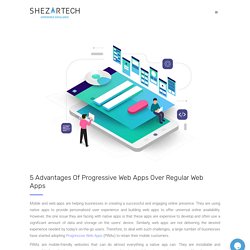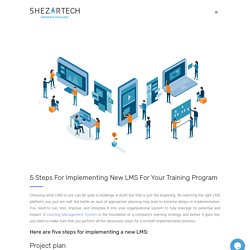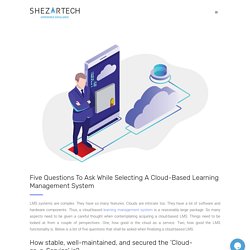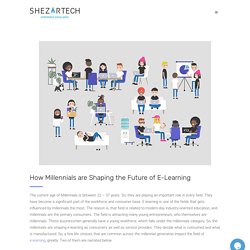Zoom
Trash

Shezartech is an award winning technology solutions company functional in areas of enterprise mobile app, web app development, analytics, learning content, elearning solutions and product solutions for mobile learning and e learning management system.
5 Advantages Of Progressive Web Apps Over Regular Web Apps. 5 Advantages Of Progressive Web Apps Over Regular Web Apps Mobile and web apps are helping businesses in creating a successful and engaging online presence.

They are using native apps to provide personalised user experience and building web apps to offer universal online availability. However, the one issue they are facing with native apps is that these apps are expensive to develop and often use a significant amount of data and storage on the users’ device. Similarly, web apps are not delivering the desired experience needed by today’s on-the-go users. Therefore, to deal with such challenges, a large number of businesses have started adopting Progressive Web Apps (PWAs) to retain their mobile customers. PWAs are mobile-friendly websites that can do almost everything a native app can.
Native-like Experience PWAs run on web technologies just like a regular web app, but they provide better user experience and functionality. Ease of Access Offline Availability Push Notifications. 5 Steps For Implementing New LMS For Your Training Program. 5 Steps For Implementing New LMS For Your Training Program Choosing what LMS to use can be quite a challenge in itself, but that is just the beginning.

By selecting the right LMS platform, you just win half the battle as lack of appropriate planning may lead to extreme delays in implementation. You need to run, test, improve, and integrate it into your organisational system to fully leverage its potential and impact. A Learning Management System is the foundation of a company’s learning strategy, and before it goes live, you need to make sure that you perform all the necessary steps for a smooth implementation process. Here are five steps for implementing a new LMS: Project plan The first step in the process is creating a project plan. Team creation You need people that will help you to execute your LMS implementation project plan. Integration and migration Trial and testing Final Launch Once you are done with the above steps, you can now make the new LMS platform live for the users.
Five Questions To Ask While Selecting A Cloud-Based Learning Management System. Five Questions To Ask While Selecting A Cloud-Based Learning Management System LMS systems are complex.

They have so many features. Clouds are intricate too. They have a lot of software and hardware components. Thus, a cloud-based learning management system is a reasonably large package. How stable, well-maintained, and secured the ‘Cloud-as-a-Service’ is? Clouds are relatively new systems. Is the system suitable for your staff, learners, and content? Three things are going to be specific to the consumer-party in a learning management system: staff, learners and content. How does the system comply with the present environment? The current learning environment could an offline system or an online learning system or combination. Is the system commercially viable? Cloud-based learning management systems are expensive. Another way a system shall be commercially worth is the ratio of ‘increase in staff performance to the amount of money pumped into the system.’ Why Should You Conduct Training Needs Analysis Amongst Your Employees.
Why Should You Conduct Training Needs Analysis Amongst Your Employees Modern-day work culture is ever-evolving.

With technological advancements, many things that are part of work environments undergo frequent changes. Organizations migrate from one technology to another. Tools that implement technologies change or get updated. New processes are established, and new workflows are designed. Employees implement learnings of their training program on a daily basis. New work methodologies, technologies, or tools that become a part of the work environment may not be easy to comprehend for everyone.
Employees may have demands about other factors of a training program than coverage. When training is delivered as e-learning, the user interface may turn out to be challenging to navigate through, for some users. To summarize, conducting a training needs analysis among your employees can benefit your organization in multiple ways. How Millennials are Shaping the Future of E-Learning. The current age of Millennials is between 22 – 37 years.

So, they are playing an important role in every field. They have become a significant part of the workforce and consumer base. E-learning is one of the fields that gets influenced by millennials the most. The reason is, that field is related to modern-day industry-oriented education, and millennials are the primary consumers. The field is attracting many young entrepreneurs, who themselves are millennials. Career Risks Millennials are more willing to experiment with their careers than the older generations.